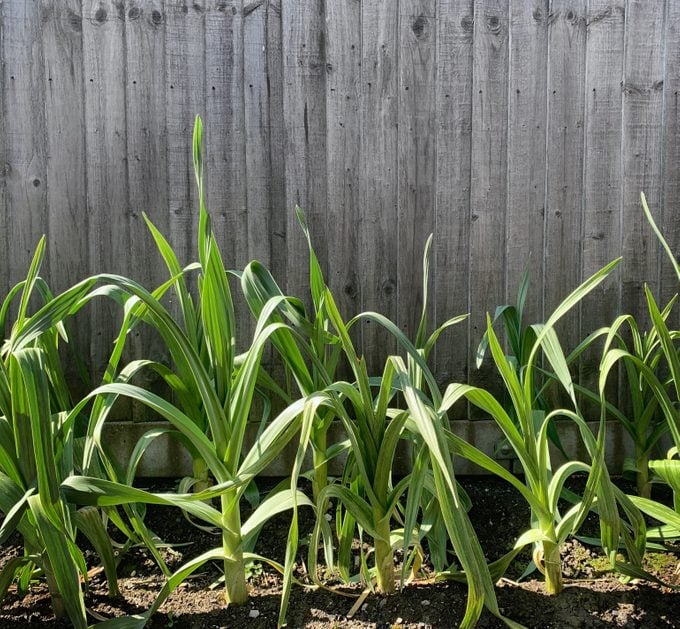This trendy allium is easy to grow and delicious to cook with.

How to Grow Elephant Garlic

Who doesn’t love garlic? The humble root vegetable packs a major punch of flavor, spice, and depth to just about any savory dish. So, it’s no wonder home cooks and gardeners are also showing interest in its supersized cousin, elephant garlic. Here’s everything you need to know about this zippy vegetable, including how to grow it yourself.
What Is Elephant Garlic?
Think of elephant garlic as a cross between regular garlic and a leek. Flavor-wise, it is most similar to a leek, with a milder taste than standard garlic. Additionally, like a leek, it has broad, flat leaves. However, appearance-wise, it looks similar to a giant head of garlic, growing up to the size of a baseball. The bulb contains smaller bulblets and, like garlic, can be found in both hardneck and softneck varieties. If you grow a hardneck version, you can also harvest and cook with the scapes.
The mature plant grows to two or three feet tall and blossoms with beautiful purple flowers. It is a biennial—completing its life cycle in two growing seasons— and will yield numerous cloves of garlic in its second year. During the first year, all its resources go into creating one large monobulb.
What’s the Best Way to Grow Elephant Garlic?
If you live in hardiness zones 3 through 9, you’re in luck: it’s incredibly easy to plant and tend to these monster bulbs. To start, find a patch of yard that gets at least six hours of full sunlight each day and minimal wind. Then, amend a nutrient-rich potting soil with some sand or grit to promote water drainage and some manure or organic material for enrichment (a standard 1:1:1 ratio works well). Get yourself a bulb of elephant garlic to plant—one plant grows from a single clove—and you’re ready to go!
Can You Grow Elephant Garlic in Pots?
Elephant garlic can be grown outside both in-ground and in plant pots. Note that in either case, it cannot be planted in the same soil as you have previously planted other alliums such as garlic, onions, leeks, and chives. This is because the new crop can catch latent diseases from the soil, such as onion white rot.
If you plan to plant the elephant garlic in a pot, be sure to use a large enough vessel. The clove must be planted at least four inches deep, not accounting for root growth, and the plant will spread one to two feet wide, so buy a big pot! Any pot you use must also have a good drainage hole for watering.
How to Plant Elephant Garlic

Sow elephant garlic in the spring or fall. Elephant garlic planted in the fall may have enough time to split into cloves or bulblets by the summer, while spring-planted elephant garlic will likely produce a monobulb at first. Plant large cloves pointy-end up about six inches deep into the amended soil. Space the cloves a minimum of eight inches apart, then cover with more soil.
How Often Should You Water Elephant Garlic?
Once you’ve sown the seeds, it’s time to talk maintenance. Immediately after sowing, lightly water the elephant garlic. Then, water your plants regularly—ideally in the morning—so that the soil remains consistently moist, but not soggy. Elephant garlic planted in containers may need more watering.
In addition to watering, be sure to weed your plot regularly, and watch out for pests, like slugs. If you are planning to eat the elephant garlic, opt for non-toxic pest control over chemical insecticides. Remember that garlic is harmful to pets, so keep them far away. Additionally, as the scapes shoot up, cut them back to divert the plant’s energy back to the bulb. After one year of growth, add more compost to the plot for best plant health.
How Do You Harvest and Store Elephant Garlic?
You’ll know elephant garlic is ready to harvest once the foliage begins to yellow, about eight months after planting for fall-sown cloves (late summer). Then, lift the bulb from the soil using a fork or garden spade; tugging by the stem will damage the plant. Collect the largest bulbs and leave the smaller ones to grow into the next year.
To store elephant garlic, cure it in a cool, dark spot for up to eight weeks. Then, trim off the roots and stem and store them in a cool (45 to 55°F) environment for up to ten months. While you wait for the next harvest, enjoy your home-grown elephant garlic in soups or braises, or just sauteed with some butter. Bon appetit!




















